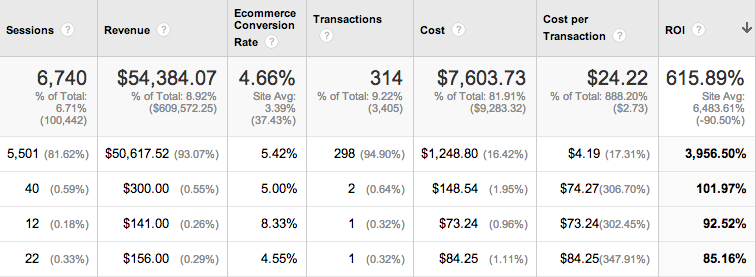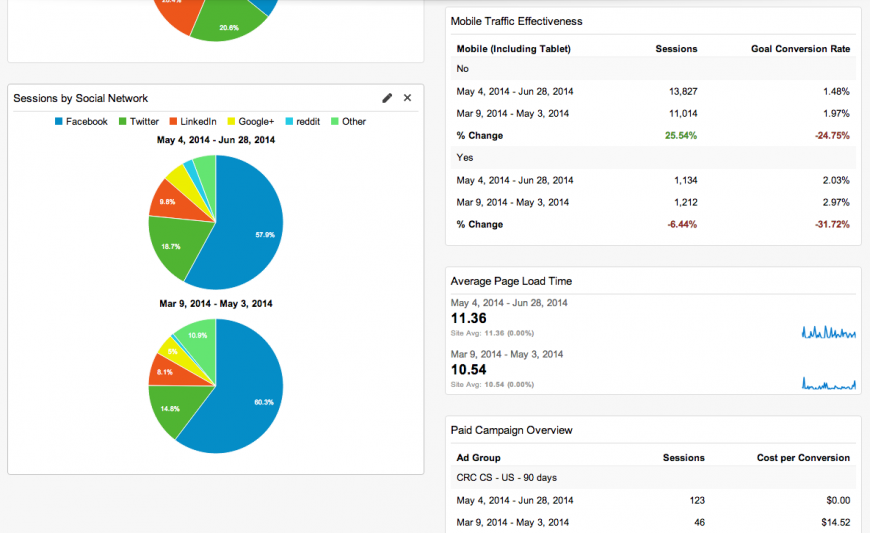
The Ultimate Foundational Guide for Higher Education Digital Marketing
3 Things You Can Do Right Now To Boost Your Digital Recruitment, Retention, and Advancement Strategies
So let me ask you this, do you think your higher education digital marketing plans are pulling their own weight?
If you hesitated to answer that, then this blog post is for you. In here, I’ll give you three simple tips for getting the most out of your school’s website. If you’re already doing all these things, then you’re off to a great start (but there’s plenty left to do afterwards).
Higher-Ed Marketing Tip 1: Install a heat map to help increase conversion rates.

You probably already know all about the difference between self-reported data and observational data. For a quick refresher, self-reported data is what people say they do and observational data is what they actually do.
Most marketers take self-reported data with a grain of salt (or at least some concurrent validity) because people like to tell you what they think you want to hear or what they believe is true.
When marketers have an opportunity to gather observational data they jump at it. It’s a chance to see how your audience actually experiences your content.
So how can your school gather observational data on a shoestring budget? It’s simple. Install Google Analytics and/or some heat mapping software.
After these tools collect a week or so of data, you can start doing some conversion rate optimization activities. For example, you can split-test minor usability changes to try and increase the number of online applications from prospective students.
Why is conversion optimization such a big deal? Well, sometimes attracting more eyeballs to your website isn’t always the best answer to lead volume challenges. Most often, the path of least resistance will be increasing the number of leads from the eyeballs you already attract.
Want to start improving your school’s conversion rate? Good!
How to get started with conversion rate optimization today.
You can optimize your school’s website for conversions on a shoestring budget (<$200) with the right tools. Collecting all the data, running your first experiment, and implementing the change should take less than 10 hours total too.
Ready to get started? Follow the steps below for a quick and dirty conversion optimization experiment.
- Install Google Analytics reporting suite.
Google Analytics is free, easy to install, and has some great reporting features. There are plenty of other analytics tools you can use as well (e.g. Omniture, HubSpot, etc.). - Install Lucky Orange heat mapping tool.
Start collecting your observational data now so that it can later be referenced when developing a split test. There are plenty of heat mapping tool options other than Lucky Orange too, depending on your site’s size (e.g. CrazyEgg, Clicky, etc.). - Nominate a goal and get a baseline measurement for its completion rate.
E.g. 0.5% of all unique visitors submit an online application
There’s plenty of variables to consider (e.g. seasonality), but you should be able to choose two similar-enough two-week periods so that you can measure your baseline and then start testing. - Survey users similar to your audience with a service like UserTesting.com.
E.g. 18-22 year olds, in the US, with average web expertise
Gathering this self-reported data can help you identify where you want to collect your observational data and formulate hypotheses for your split-test.If you’re interested in a customized user test and a comprehensive website audit, you should talk to Bob Johnson. He’s a legend in the higher-ed marketing space and can bring tremendous insights to the table. - Formulate an A/B split test and use a tool like Optimizely to implement.
E.g. Fewer student prospects would abandon our online application if we move the _____ field to the end of the application.
Analyze your self-reported data from user tests and compare it with your observational data. See any problematic patterns? Maybe high abandonment for a particular form field? Users confusing an image for a button? Great, now put your theory to the test.There are dozens of different ways to implement a split test. Most require a lot of technical work, but they don’t have to. Optimizely and some newer split testing technology let you conduct split tests in a fraction of the time. You have to try it to believe it. - Determine a winner, implement the change, and profit.
Your split test should reveal statistically significant results in a few weeks or less, depending on the amount of traffic to the page.If you were right, you can turn off your testing tool and implement right away. If you were wrong, then it’s simply time to reformulate your hypothesis and test again.
Want to see an example of the conversion rate optimization process for schools in action? Check out our case study for a school and learn how we almost doubled their online application rate.
Higher-Ed Marketing Tip 2: Perform a few basic SEO activities to increase visibility.

Search engine optimization. You’ve heard of it. Maybe you’ve even been burned by it with an unscrupulous vendor. Whatever you do, don’t ignore it.
SEO for schools remains incredibly important. It’d be nice if you didn’t have to optimize your website for search engines, but the fact remains that search engines need your help.
The best type of SEO does not manipulate search engines into increasing your website’s ranking; that’s what snake oil, $300/month services try to do. Actual SEO helps search engines understand your website; a better understanding should lead to a better ranking.
Search engine robots are limited in the types of conclusions they can draw from your website’s code. If your website’s code is a mess and doesn’t clearly communicate the type of content you have, then that’s negatively impacting your content’s visibility on search engines.
So what are some SEO activities you can do today to improve your school’s visibility? We’ll cover a couple in the list below.
How to get started with SEO for your school today.
SEO activities come in all shapes and sizes; some take place on your website, some take place on third party websites. The most basic SEO activities for a school can be done right on your site.
Below I’ll list three SEO activities that can be done by digital novices or veterans alike.
- Perform some keyword research to update your metadata.
Every page on your website can have metadata attached to it — title of the page, a description of the page, author of the page, etc. You can use a tool like Screaming Frog to extract all of your website’s metadata and export it into a spreadsheet to review.Search engines extract this metadata when it’s available and it helps them determine the relevancy of your page for search terms. It’s also the data that’s used to populate the blue links and descriptions on search engine results pages.You can optimize your webpages metadata by doing some keyword research to find out what types of words or phrases searchers are using to find that type of content (e.g. “electrician training program”) and then including those keywords in the page’s metadata. You can use Google’s Keyword Planner to conduct that keyword research. - Structure your data.
A new type of HTML markup called schemas allows you to tell search engines more about the content they’re indexing. You append a set of “types” to pieces of your content and search engines will automatically associate them with a set of properties (e.g. understanding that the letters and numbers that make up your address are, in fact, an address).Implementing structured data for educational organizations quickly becomes complex, but there is some very low hanging fruit that can quickly be plucked. Google offers a Structured Data Markup Helper that lets you highlight information on your website and then automatically generates updated HTML for your webmaster to easily implement. - Remember SEO when publishing great content.
Elements of content strategy cross into the silo of SEO activities. After all, the job of a search engine is to link people to content.You can add some basic SEO elements into your publishing strategy to maximize your content team’s efforts. For example, nominating a target keyword for each new piece of content will help that page rank immediately after publishing it.
Want to see how quickly these basic SEO activities can impact your website’s traffic? Check out our case study for a school which explains how we increased search traffic by 469.79% with some foundational SEO activities.
Higher-Ed Marketing Tip 3: Pay $1,000 to earn $10,000.

Paying for website visitors only makes sense if those visitors end up paying you back. It’s a simple concept and one you probably understand fairly well.
But what’s the secret to generating high ROI for your digital recruitment, retention and advancement strategies? Online research takes student prospects far and wide. Paying for prospects during the early-to-middle phases of the decision-making process can often be a crapshoot — the prospect gathers information about your programs but you may never see them again.
The secret to profitable paid media campaigns for schools comes down to relevance. Are you aligning your campaigns with the decision-making process? Does your content reflect the various stages your prospects are at within the decision-making process?
Carefully calculated segmentation is essential for any marketing campaign, but with paid media it’s even more critical. Carefully segmented campaigns can be better optimized for relevance and that can be all the difference between negative ROI and positive ROI.
So you want to know some quick and easy ways to start segmenting your campaigns?
How to start improving your school’s paid advertising campaigns today.
Paid media management is very much a number’s game, but sometimes it’s the words that make the biggest difference.
A couple tweaks to your content — ad copy, web pages, etc. — is often all that you need to move the profitability needle on your prospect recruitment, retention and advancement campaigns. Give these two tips a try and you’ll be amazed at how much your ROI increases.
- Create custom landing pages.Do your ads lead to custom landing pages that match your prospects intent?For example, if somebody searches “computer science school”, they’re probably looking for information about computer science programs AND the school offering them. Taking the searcher to a page that ONLY talks about ONE of these things — like a program page or your school’s homepage — increases the likelihood that the searcher will abandon their quest for information before they convert (i.e. contact you or submit their information).By using custom landing pages, you can increase the rate that you capture student prospects early in the decision-making process and then start nurturing them as they get closer to making their decision (marketing automation is a great way to keep that conversation going).Designing your own landing pages is usually the best way to do this, but you can also use landing page creation services like Unbounce to get started on understanding what makes a good landing page.
- Run remarketing campaigns
Are you advertising to prospects who’ve already shown interest in your school?Remarketing lets you narrow your audience down to only those who have visited your website. You can further narrow your audience with more specific criteria (e.g. only show ads to people who visited at least 3 pages on the site, one of which was the computer science program page).And the best part about remarketing? It’s incredibly cheap. You’re not bidding against other schools over general keywords like “computer science program”. You’re simply bidding for any unsold ad opportunities your audience may come across.So if you want to run a cheap campaign that follows interested prospects across social media and the rest of the web, then you need to start remarketing with AdWords, Facebook, and other ad networks like AdRoll.
Want to learn how to hyper-target your paid media campaigns by best position, day, and hour? Check out this webinar from one of our team members.
Bonus Tip: Schedule a marketing dashboard to review key insights.

Creating memorable campaigns across your marketing channels is just the start. If you’re not actively reviewing the outcomes from those efforts, then it’s hard to improve any kind of higher education digital marketing strategy.
To help you repeat your marketing successes and avoid repeating your failures, a marketing dashboard is essential. A marketing dashboard allows you to quickly extract critical insights so you can address problems and opportunities as soon as they happen.
Interested in setting up a dashboard? I have you covered.
How to get started with digital marketing dashboard building today.
Creating a marketing dashboard should be easy for higher education marketers. Each analytics platform has its own way of doing this, but we’ll focus on the Google Analytics version.
- Watch our webinar on building Google Analytics dashboards.This webinar covers all the basics for building a dashboard. Ethan Reese, the host, does a great job explaining how to create your own custom dashboard. Check it out and if you have any questions, feel free to ask us!
- Apply our custom Google Analytics dashboard to your account.If you signed up for access to our webinar then you also have the link to our pre-formatted Google Analytics dashboard. Add that dashboard to your account and start customizing it for your digital campaigns.Google also maintains its own list of dashboard templates, custom reports, and more if you want to explore the subject even further.
The main takeaways.
If you’re not walking away from this post with some actionable advice, then that’s a good thing. That means you’ve already completed some foundational higher education marketing activities. Now, it’s time to build on that.
If you’re somebody who did take away some new “to do list” items, you’re in good company too. Most websites for education institutions aren’t doing these things so you’re not too far behind. The biggest difference is that you’re reading marketing posts like these and are actively attempting to improve your institution’s website. You’re ahead of everyone who’s sitting still.
If you need help with any of what was discussed or have questions, then you can always get in touch with our team. We love marketing and we love teaching marketing. Let us know how we can help you.
Most newsletters suck...
So while we technically have to call this a daily newsletter so people know what it is, it's anything but.
You won't find any 'industry standards' or 'guru best practices' here - only the real stuff that actually moves the needle.






